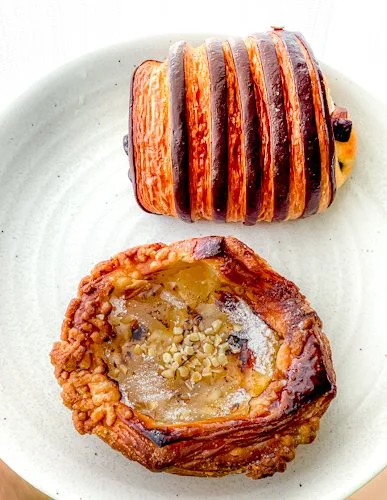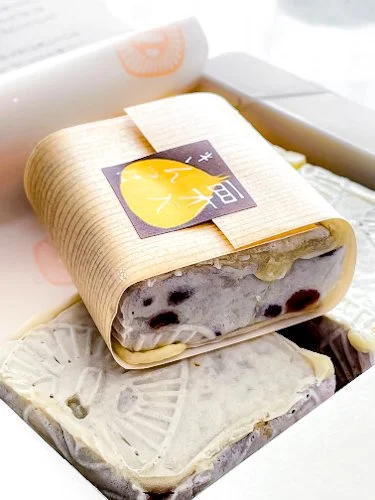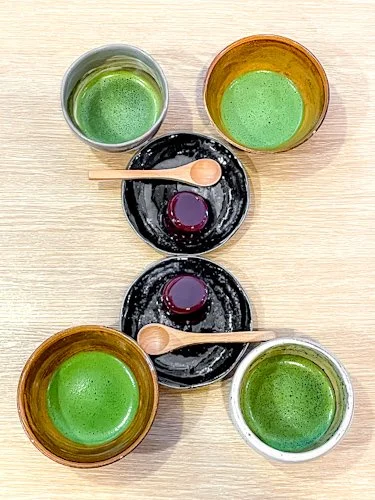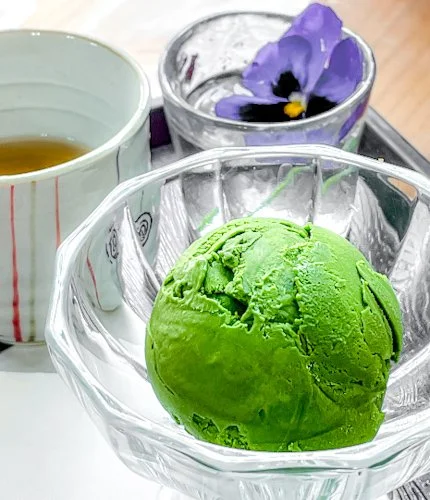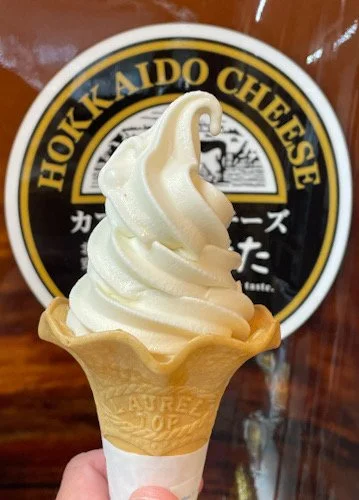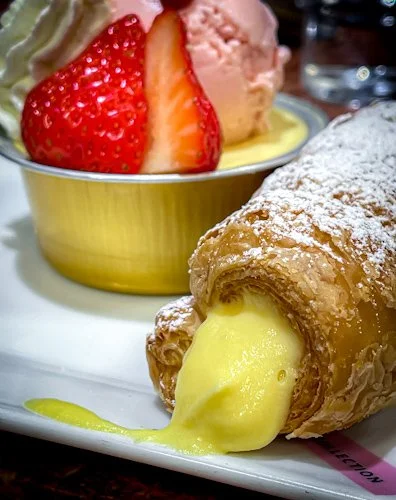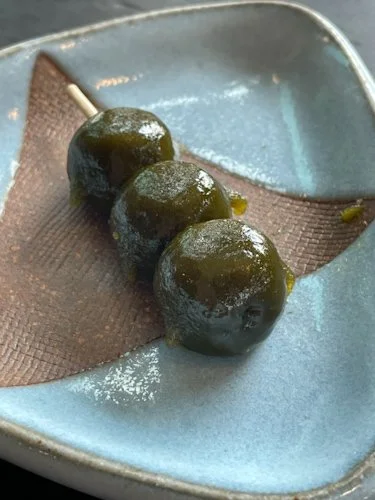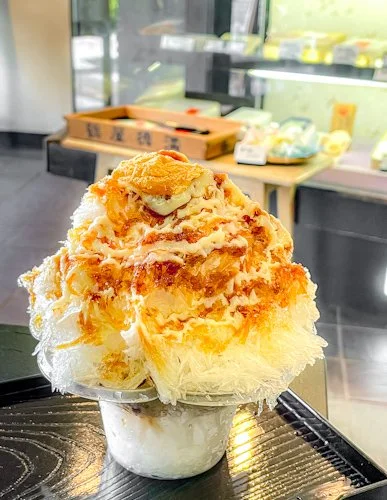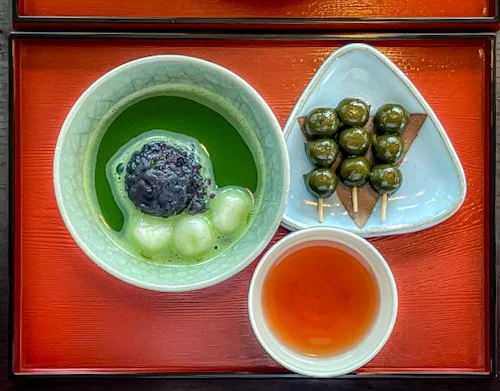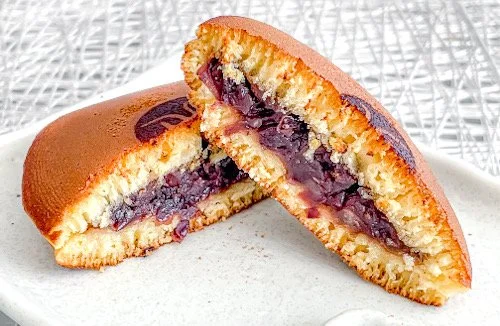Dessert in Japan: Sweet Travels
If you’re looking to come to Japan, one of the big reasons is – I’m going to go ahead and guess – food?
And if you’re a foodie traveling to Japan, is it safe to say that your quest for legit Japanese food goes beyond savory to include sweet as well?
If so, you’ve come to the right place. Not just to Japan, that is, but to this Japan Travel Pros guide to finding (and eating!) the best dessert in Japan.
Japanese desserts are popular among locals and visitors alike, thanks to their creative artistry and sheer variety. From centuries-old wagashi confections to twists on the classics and brand new creations, sweets in Japan are a treat for people of all ages.
Prelude to Dessert: Why We’re Leaving Out Patisserie in Japan (for Now)
By the way, before we get into dessert in Japan, let’s briefly brush on pastry & patisserie.
Japan’s got some of the best pastry in the world. The influence of French patisserie and other forms of bakery have been present, active and evolving in Japan for over a century. It’s one of the richest and most advanced patisserie scenes in the world.
So why aren’t we talking about it in this article?
Well, Japan’s pastry game is so good, it really deserves an article of its own. For now, here, let’s focus on classic Japanese sweets and modern desserts (including cakes and other sweet creations, which are delicious in their own right and among the world’s best). When relevant, we’ll make mention of a pastry shop here or a piece of patisserie there.
The Art of Wagashi: Traditional Japanese Sweets
At the heart of Japanese dessert culture lies wagashi.
What’s a wagashi, you ask?
Wagashi are sweets that have been enjoyed in Japan for centuries. These Japanese confections are edible art, reflecting Japan’s culture and the way we appreciate seasonality and aesthetics.
Seasonal Delights: Wagashi Sweets Year Round in Japan
Wagashi often mirror the changing seasons, with flavors and designs that evoke specific times of the year.
In spring, you will encounter sakura mochi, a pink rice cake filled with sweet red bean paste and wrapped in a pickled cherry blossom leaf. After all, cherry blossom viewing (hanami) is a favorite Japanese pastime, and recently it’s become quite popular among tourists in Japan as well. Sakura mochi make a great addition to your hanami picnic in Kyoto, Tokyo, Osaka or anywhere in Japan you happen to visit during the cherry blossom peak.
Summer brings refreshing offerings like mizu yokan, a chilled red bean jelly that provides relief from the heat.
Speaking of yokan, the mushi-yokan (chestnut with sweet red bean paste) and imo-yokan (sweet potato) are popular autumn sweets in Japan.
Wagashi for winter? We’ve got that! Enjoy “sake manju” which are sweet, dense dessert buns made with (you guessed it) Japanese sake. Want something sweet but soupy to warm you up? That’s oshiruko, and it’s delicious in Japan’s cool winter months, made with red bean and toasted sticky rice (mochi).
Tea Ceremony Companions: Wagashi Sweets with Matcha
Many wagashi are crafted specifically to complement the bitter notes of matcha in the tea ceremony.
These sweets, known as namagashi, are often shaped to resemble natural objects like flowers or leaves. The contrast between the sweet wagashi and the bitter tea creates a balance that elevates the entire experience.
Notable Wagashi Varieties
Daifuku: Soft mochi rice cakes filled with sweet bean paste or fruit
Dango: Chewy rice flour dumplings often served on skewers
Dorayaki: Red bean paste sandwiched between two small pancakes
Yokan: A thick, jellied dessert made from red bean paste, agar, and sugar
Japanese Sweets Nowadays: Modern Twists on Classic Flavors
While wagashi continue to be enjoyed in Japan’s sweets scene, contemporary Japanese desserts often fuse classic flavors with creative technique and presentation.
Matcha Mania: Tea Not Just with Japanese Dessert But Inside
The distinct, slightly bitter flavor of matcha green tea has found its way into countless modern desserts.
From matcha tiramisu to matcha ice cream, this versatile ingredient bridges the gap between classic and contemporary sweets in Japan. The vibrant green color of matcha-infused desserts has made these Japanese desserts Instagram favorites, further propelling their popularity both in Japan and abroad.
Mochi Reinvented: Sticky Japanese Sweets
The chewy texture of mochi has inspired numerous creative applications.
Mochi ice cream, where a thin layer of mochi encases a ball of ice cream, has gained international popularity. Some innovative cafes even offer mochi pizza crusts or mochi-wrapped cheesecake. The versatility of mochi has led to exciting fusion desserts that blend Japanese and Western flavors.
Regional Specialties: A Sweet Tour of Japan
Each region of Japan boasts its own unique dessert specialties, often reflecting local ingredients and cultural preferences. Let's take a mini tour of Japan's sweet offerings:
Hokkaido: Milk & Cheese Delights
Renowned for its dairy, Hokkaido offers treats like the Shiroi Koibito ("White Lover") langue de chat cookies and rich, creamy cheesecakes. The region's milk-based soft serve ice cream is a must-try for any dessert enthusiast.
We’ve also enjoyed soft-serve ice cream in Hokkaido that was blended with cheese. Amazing!
Hokkaido's cheesecakes, in particular, have gained fame for their light, fluffy texture and subtle sweetness, making "Tokyo Japanese cheesecake" a popular search term for tourists planning their culinary adventures.
Visiting Sapporo? Don’t miss ROYCE’ chocolates, with locations in the city as well as at New Chitose International Airport. Like many of Japan’s airports, Chitose (the main gateway airport for Sapporo & Hokkaido) has a great selection of dining (including a ramen street!) as well as food shops for souvenirs.
Kyoto: Refined Elegance in Classic Japanese Sweets
As the historical capital of Japan, Kyoto is known for its refined wagashi.
The city's yatsuhashi – thin, folded crepes of rice flour filled with sweet bean paste – are a popular souvenir. Kyoto wagashi often feature intricate designs inspired by the city's rich cultural heritage, making them a visual treat (and a delicious one at that!).
Kyoto’s department stores are good places to shop for sweet souvenirs, convenient if you’re catching a train to travel on to Osaka or Tokyo. Even better, many of the stores along Ninenzaka and Gion’s main streets have been around for ages, and take their Japanese sweets very seriously.
Kobe: A Modern Japanese City with a Big Sweet Tooth
Kobe is quite famous across Japan for its varied and very tasty sweets and desserts.
At Hon-Takasogoya in Motomachi, they’ve been in business since Year 10 of the Meiji Era – that’s 1867! Try their an-feuille and the signature kintsuba (bonus if you can get chestnut in season).
Other Kobe establishments that are great for dessert and/or souvenirs include:
Kobe Fugetsudo (Motomachi)
Ichibankan (Motomachi)
Freundlieb (between Sannomiya & Kitano hill near the bullet train station)
Morozoff (also has locations in Osaka & elsewhere)
Juccheim
Konigs-Krone (with the famous cronut-like pastry)
Now, with some of these shops, we’re starting to venture into the pastry/patisserie category. Largely we will save those for a different article, but it’s still worth mentioning here.
If you’ve got a sweet tooth, Kobe is a great addition to the itinerary on your Japan food travels. It’s right by Osaka and Kyoto, too, so come on down!
The Rise of Dessert-Only Restaurants
In recent years, we have seen a boom in dessert-focused eateries in Japan, from specialized parfait cafes to tasting-menu restaurants devoted entirely to sweet courses.
What are the reasons for these restaurants focusing on sweets in Japan? Well, there are many.
For starters, Japanese desserts are in a league of their own. Rather than co-mingle with the savory side of things, many dessert chefs prefer to focus on sweets, sweets & more sweets in Japan.
And that’s just fine with the Japanese public. Because cafes and dessert restaurants are generally great places to linger and socialize on a couple’s, friends or family trip to Japan – or, for solo travelers in Japan, to enjoy coffee and dessert and stay in the air conditioning or heat in a table for one (no stigma in Japan for this).
Also, many restaurants in Japan – especially those in the comfort food category, and most notably ramen shops – are not places one should linger, but instead are eat-and-go type situations. Therefore, it’s nice after a meal to move on to a nearby cafe or dessert restaurant, find a cozy booth or table and stake one’s territory for much of the afternoon or evening.
Parfait Perfection: Popular Sweets in Japan
Japanese parfaits are a spectacle unto themselves, often towering creations that layer ice cream, fruit, cake and various toppings in tall glasses.
Cafes like Salon de Mon Cher in Osaka and Tokyo have elevated the parfait to an art form, offering seasonal specialties that showcase premium ingredients. These elaborate parfaits have become a social media sensation, with food bloggers and tourists alike sharing photos of these impressive desserts in Japan.
Dessert Omakase
Some innovative restaurants now offer dessert-only omakase (chef's choice) menus.
These multi-course experiences take diners (desserters?) on a journey through the delights of dessert in Japan, often incorporating savory elements to create a balanced progression of sweets. This trend highlights the growing appreciation for sweets in Japan as a sophisticated culinary experience in its own right.
This sounds like a great food adventure on a honeymoon in Japan, doesn’t it?!
Kissaten & Cafes: Sweets in Japan with a Side of Premium Coffee
We did a whole article a while back about the kissaten, Japan’s classic cafe scene.
Well, what goes better with coffee than… dessert?! In Japan, nothing does, they’re a natural match.
You can find a wide range of kissaten styles and cafe types in Japan, from the Golden Route cities of Tokyo, Kyoto and Osaka, to notable sweet-tooth fiends like Kobe, Nagoya, Sapporo and many others.
When it comes to kissaten and cafes in Japan, it’s kind of hard to go wrong. Sure, many locals have their favorites for coffee and dessert in Japan. As a traveler here, it’s probably better to check Google Maps (or follow your eyes & nose) and see what’s close by.
You can count on solid desserts and good coffee – and an uninterrupted experience to socialize with friends/family or enjoy time alone.
Street Sweets in Japan: Casual Indulgences
Japan's street food scene includes an array of portable sweets ideal for on-the-go snacking or casual enjoyment.
One thing to note is that, unless you’re at a festival, street food in Japan generally refers to something you buy at a stall or small shop but take elsewhere to eat. It’s considered bad manners to walk and eat. You might see people doing this, especially in the highly touristic areas, but now that you know the etiquette, well it’s your choice.
Taiyaki and Imagawayaki: Desserts for Kids of All Ages
These fish-shaped (taiyaki) or round (imagawayaki) cakes are filled with sweet red bean paste, custard or other fillings.
Watching them being made in specialized molds is almost as enjoyable as eating them. Hey, I said almost.
The aroma of these freshly baked treats wafting through the streets is an iconic part of the experience of enjoying dessert in Japan.
Crepes with a Japanese Twist
Harajuku-style crepes, popularized in Tokyo's trendy Harajuku district, stuff French(~esque) crepes with an array of sweet fillings, often including ice cream, fruits and whipped cream. These colorful, handheld desserts reflect the playful and fashion-forward spirit of Harajuku’s days gone by. While it’s very touristy nowadays, the crepes can be found elsewhere around Tokyo and across much of Japan.
Seasonal Sensations: Japan's Ever-Changing Dessert Scene
One of the most charming aspects of Japanese dessert culture, which we touched on earlier, is its strong connection to the changing seasons. Throughout the year, you'll find limited-edition sweets that celebrate seasonal ingredients and cultural events.
By the way, the word for “limited edition” in Japanese is “gentei.” We really like gentei, like, a lot! People here will be more likely to buy gentei anything, not just sweets, in Japan.
Springtime Sweets in Japan: Cherry Blossom Boom
When cherry blossoms bloom, Japan goes into full sakura mode.
Desserts featuring delicate cherry blossom flavors abound, from sakura mochi to sakura-flavored Kit Kat bars. These pink-hued treats capture the ephemeral beauty of the cherry blossom season… and they’re another “gentei” thing for us to consume!
Summer: Cooling Delights for Dessert in Japan
Summer in Japan brings a variety of refreshing desserts designed to beat the heat.
Kakigōri, or shaved ice, is a beloved summer treat that comes in countless flavors, from traditional matcha to exotic fruit combinations. One of our favorite places for kakigori is on the busy tourist street in Nara, next to Nara Park. It’s a Japanese sweets store called Tsuruya-Tokuman. Their wagashi are nice; and the kakigori shave ice is made with a pure syrup, not the bottled store brand, so the taste is better and you don’t feel dehydrated or jumpy afterwards.
Another summer favorite is warabimochi, a jelly-like confection made from bracken starch and topped with kinako (roasted soybean flour).
Autumn: Harvest Flavors for the Sweet Tooth
Fall desserts in Japan often feature seasonal ingredients like sweet potato, chestnut and persimmon.
Mont Blanc, a European-inspired dessert of sweetened chestnut purée, becomes particularly popular during this time. You'll also find momiji manju in areas famous for autumn leaves – these maple leaf-shaped cakes are typically filled with red bean paste or chestnut cream.
Winter: Festive Sweets in Japan’s Cooler Months
Winter in Japan brings its own set of seasonal sweets, many associated with the New Year celebrations.
Oshiruko, a sweet red bean soup often served with mochi, is a comforting winter dessert. During the Christmas season, you'll find a uniquely Japanese tradition: strawberry shortcake. This light, fluffy cake topped with fresh strawberries has become the quintessential Japanese Christmas dessert (after that quintessential Japanese Christmas dinner from KFC – no, really, no joking!).
The Global Influence of Japanese Desserts
As Japanese cuisine gains popularity worldwide, its desserts are also making waves on the international stage. The global focus on Japanese sweets has led to some interesting developments:
Mochi Ice Cream from Japan Goes Worldwide
What started as a niche product in Japanese-American communities has become a global phenomenon. Mochi ice cream is now available in supermarkets around the world, introducing international consumers to the unique texture of mochi combined with familiar ice cream flavors.
Matcha: Japan’s Green Tea Gift to Global Desserts
The distinctive flavor and health benefits of matcha have made it a favorite ingredient in desserts worldwide. Matcha lattes, matcha cheesecakes, matcha ice cream… this vibrant green tea powder has found its way into countless menus for dessert in Japan and around the world.
Fusion Creations: Japan’s Sweets Know No Rules
Chefs around the world are incorporating Japanese flavors and techniques into their dessert creations. You might find a crème brûlée flavored with yuzu, a chocolate tart with a hint of wasabi or a paris-brest filled with sakura-flavored cream. These fusion desserts showcase the versatility of Japanese flavors in a global culinary context.
The line between savory and sweet continues to blur, with chefs incorporating traditionally savory ingredients like soy sauce, miso or wasabi into dessert creations. This trend reflects a growing appreciation in Japan’s sweet & savory sides both for complex flavor profiles and unexpected combinations.
Sustainable Sweets in Japan
As environmental concerns (or SGI as we seem to have taken to calling it in Japan) become more pressing, many Japanese confectioners are exploring sustainable practices. This includes using local, seasonal ingredients; reducing packaging waste (if you know Japan, this is really a big one!); and creating plant-based versions of Japanese sweets to cater to the growing vegan market demand for sweets in Japan.
Nostalgia with a Twist: Showa Sure Is Sweet in Japan
There's a growing trend of reimagining nostalgic favorites for dessert in Japan. Classic candies and snacks from childhood are being transformed into sophisticated desserts, often with a touch of alcohol or bitter flavors to appeal to grown-up tastes. These go along with the general nostalgia for “Showa” era everything in Japan, referring to the decades (1960s-1980s) when Japan’s economy was booming and (as many now feel) life felt “simpler”.
Healthy and Dietary-Friendly Options for Sweets in Japan
As health consciousness grows, so does the availability of desserts catering to various dietary needs & preferences.
Plant-Based Innovations: Vegan Dessert in Japan
Vegan desserts in Japan are becoming increasingly popular, with shops like Tokyo's Hal Okada Vegan Sweets Lab creating plant-based versions of classic Japanese sweets. These innovative treats allow those with dietary restrictions to experience the full range of Japan’s dessert culture.
Low-Sugar Alternatives
Some confectioners now offer low-sugar or sugar-free versions of popular desserts, using alternative sweeteners or naturally sweet ingredients like fruit to cater to health-conscious consumers. This trend aligns with the Japanese appreciation for subtle sweetness, as seen in many classic wagashi recipes.
The Intersection of Art & Dessert in Japan
Japanese dessert artisans walk a fine line between confectionery and visual art, creating edible masterpieces that are almost too beautiful to eat. But eat them, we will!
Mizoguchi Asako's "Nerikiri" Art
Master wagashi maker Mizoguchi Asako has gained international recognition for her very detailed nerikiri – a type of wagashi made from white bean paste and mochi.
Her creations often resemble delicate flowers or birds, showcasing the highest level of artistry in wagashi. Mizoguchi-san’s work exemplifies the Japanese concept of "eating with your eyes," where visual presentation matters pretty much equally to taste.
3D Latte Art
While not strictly a dessert, Japan's 3D latte art often incorporates sweet elements. Baristas create intricate sculptures atop lattes, ranging from cute animal characters like bears, cats and dogs (we love kawaii in Japan, after all) to famous landmarks, using foamed milk and sometimes colorful syrups. This trend has spread to dessert cafes, where similar techniques are applied to create captivating designs on cakes and puddings.
Food Travel in Japan: Desserts & Sweets
Whether you're savoring a meticulously crafted namagashi in a historic Kyoto or Uji tea house, indulging in a towering parfait in a trendy Tokyo or Osaka cafe, or enjoying a simple daifuku from a local confectioner, Japanese desserts invite you to slow down, appreciate the artistry and enjoy a moment of sweet bliss.
Got a favorite sweet or dessert in Japan? Let us know in the comments below.
And stay tuned for that article on patisserie in Japan… coming soon!
FAQ - Frequently Asked Questions About Dessert in Japan
-
Generally, traditional Japanese desserts are less sweet than many Western counterparts. They often rely on the natural sweetness of ingredients like red beans or rice, with sugar used more sparingly. However, modern Japanese desserts, especially those influenced by Western pastry techniques, can be quite sweet.
-
It's hard to pinpoint a single most popular dessert, as preferences vary by region and season. However, items like daifuku (mochi stuffed with sweet filling), dorayaki (red bean pancake sandwich), and various flavors of ice cream are widely enjoyed across the country.
-
Presentation is crucial in Japanese culinary culture, and desserts are no exception. Many wagashi are designed to resemble natural objects or evoke seasonal imagery. Even casual sweets often have a level of aesthetic appeal, reflecting the Japanese concept of "eating with your eyes."
-
Many tourist areas in Japan offer tea ceremony experiences that include wagashi. In Kyoto, the heart of tea culture, numerous tea houses provide these services. Talk to Japan Travel Pros about hooking you up with a tea ceremony on your travels in Japan!



